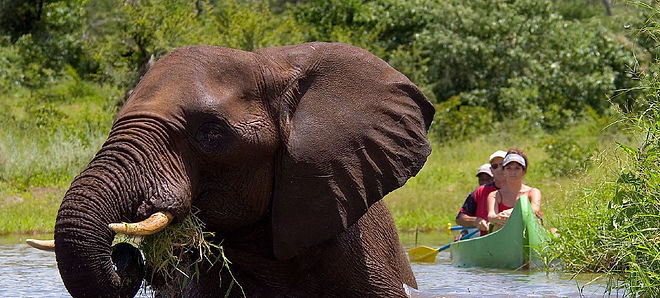


Your one stop site on everything Victoria Falls - Mosi Oa Tunya!
"One of the seven wonders of the world - a UNESCO World Heritage site"

VisitVicFalls
Healthy Travel Packing List:

General Stuff:
A list of a few things you might want to consider packing for your trip in addition to your basic toiletries and clothes to make your journey more comfortable.
-
Comfortable hiking boots in the event you're on a safari; encounters with snakes and insects are possible so boots will help protect your feet. However, if you're only exploring the falls and its vicinity then water proof shoes are the way to go as you may get wet from the spray from the falls. It is possible to wear sandals or slippers around town and the areas local to the falls.
-
Hat - given the intense sub-tropical heat and sun, preferably a broad-rimmed hiking hat that will help protect your neck, ears, and face.
-
Sunscreen – A must, to protect the exposed parts of your skin from sunburn - (SPF 15 or greater) with UVA and UVB protection (essential).
-
Insect Repellent (preferably with DEET) - Mosquitoes
-
Poncho or Raincoat - very useful for shielding yourself and/or your equipment getting drenched in the falls rainforest, you could hire or buy ponchos from local stores.
-
Quick-drying Clothing - chances are, you're going to get wet from either sweat or spray from the falls or both! These clothes will at least help keep you relatively comfortable and even re-usable later on in the trip after initial use. Light Long sleeve and long pants for evenings to serve as an additional protection against both sunburn and mosquito bites.
-
Sunglasses – for protection from prolonged exposure to the sun's ultraviolet rays.
-
Antibacterial hand wipes or alcohol-based hand sanitizer containing at least 60% alcohol
-
Permethrin (insect repellent for clothing) - needed if spending significant times outdoors. Clothing can also be treated at home in advance.
-
Bed net.
-
Safety equipment (for example, child safety seats, bicycle helmets)
-
Earplugs
-
Water purification tablets
-
Latex condoms
-
Power supply and adapters
Some other items worth bringing to enhance your experience include...
-
Lots of Memory or Film or Portable Hard Drive – you certainly will be taking loads of photos.
-
Wide Angle Lens - useful for expansive landscape photos, especially for a waterfall as wide as Victoria Falls
-
Telephoto Lens - if you're a wildlife buff, you'll want these to take photos of wild animals (big game, monkeys, baboons, snakes etc.) in their natural habitat.
-
Remember to pack extras of important health supplies in case of travel delays. This is especially important for items that may be difficult to get at your destination, like prescription medicines.
-
You may not be able to purchase and pack all of these items, and some may not be relevant to you and your travel plans. Some items, like your prescriptions, sunscreen, and insect repellent, should go with you on almost every trip. Talk to your doctor about which items are most important for you.
-
This list is general and may not include all the items you need. Some travellers may need additional health items, such as travellers who are pregnant, immune compromised, or traveling for a specific purpose like humanitarian aid work.
-
Prescription medications that you regularly take and copies of your prescriptions
-
Eyeglasses and contacts, copies of your prescription for glasses/contacts. Consider packing spare glasses and contacts in case yours are damaged.
-
Needles or syringes, such as for diabetes. (Requires a letter from your doctor on letterhead stationery.)
-
Inhalers
-
Epinephrine auto-injectors (EpiPens)
-
Medical alert bracelet
-
Antibiotic for travellers’ diarrhoea
-
Commercial suture/syringe kit to be used by local health care provider. (Requires a letter from your doctor on letterhead stationery.)
-
Medicine to prevent altitude sickness
-
Medicines to prevent malaria, if appropriate
Medicines/Medical supplies for existing conditions:
Special prescriptions for the trip:
What to Bring:

Over-the-counter medicines:
-
Antacid
-
Diarrhoea medicine (for example, loperamide [Imodium] or bismuth subsalicylate [Pepto-Bismol])
-
Antihistamine
-
Motion sickness medicine
-
Cough drops
-
Cough suppressant/expectorant
-
Decongestant
-
Medicine for pain and fever (such as acetaminophen, aspirin, or ibuprofen)
-
Mild laxative
-
Mild sedative or other sleep aid
-
Saline nose spray
-
Prescription medications that you regularly take and copies of your prescriptions
-
Eyeglasses and contacts, copies of your prescription for glasses/contacts. Consider packing spare glasses and contacts in case yours are damaged.
-
Needles or syringes, such as for diabetes. (Requires a letter from your doctor on letterhead stationery.)
-
Inhalers
-
Epinephrine auto-injectors (EpiPens)
-
Medical alert bracelet
Other recommended supplies:
First-Aid Kit
-
1% hydrocortisone cream
-
Aloe gel for sunburns
-
Antifungal and antibacterial ointments or creams
-
Insect bite treatment (anti-itch gel or cream)
-
Antiseptic wound cleanser
-
Bandages (multiple sizes), gauze and adhesive tape
-
Elastic/compression bandage wrap for sprains and strains
-
Moleskin or mole foam for blisters
-
Scissors and safety pins
-
Cotton swabs (Q-Tips)
-
Tweezers
-
Digital thermometer
-
Disposable gloves
-
Eye drops
-
Oral rehydration salts
Paperwork
-
Health insurance card (your regular plan and/or supplemental travel health insurance plan) and copies of claim forms.
-
Proof of yellow fever vaccination (if required) or medical waiver
-
Copies of all prescriptions, including their generic names
-
Contact card with the street addresses, phone numbers, and e-mail addresses of the following:
-
Family member or close contact remaining in your home country
-
Health care provider(s) at home
-
Lodging at your destination
-
Area hospitals or clinics, including emergency services
-
Your native embassy or consulate in the destination country or countries.